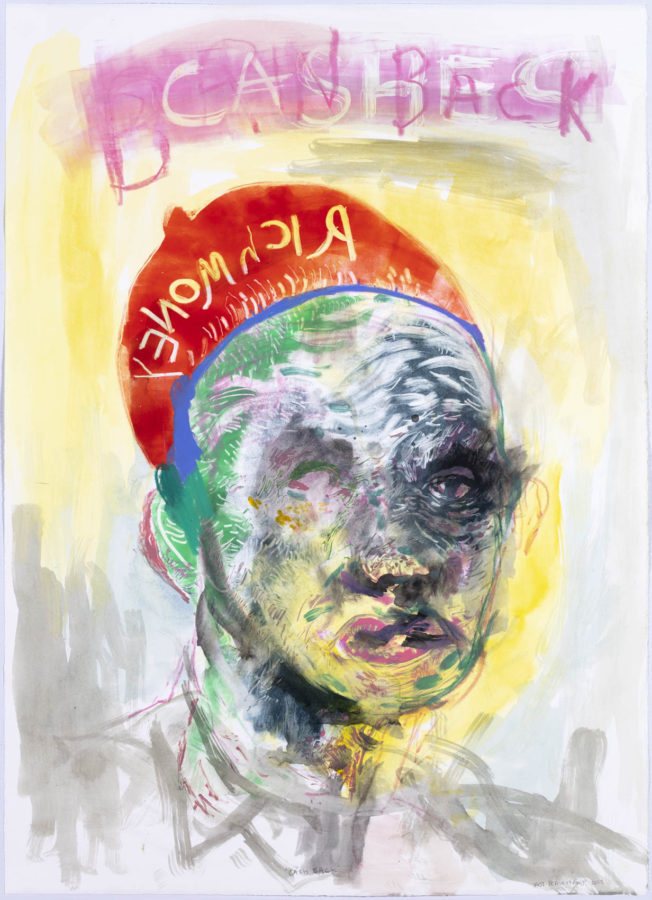Written by Lukanyo Mbanga
Vusi Beauchamp’s art caught me in quite an aggrieved moment. On my way to an earlier monotype exhibition at David Krut Projects, I found myself in a sort of high-risk adventure trail, skipping over sleeping homeless people, holding my breath from the intoxicating fumes of chaotic roads, street-stall food and desperation. Much like Vusi’s haunting depiction of a cackling Mickey Mouse, it all felt eerily comical circling a makeshift house made of election posters of politicians giving their ear to ear to smiles. Comical but not funny.

Oil, acrylic, charcoal, spray paint and oil pastels on canvas
258 x 200 cm


There couldn’t be a more appropriate time to delve into the conversation that Vusi has opened in his work. When the lights go out (and they’ve been going out quite often these days) you have a lot of time to think. For me a thought that’s been arising more often that I’d like to admit is where do I belong? I am South African. My history makes me South African. My mom and mother and her mother’s mother are from here, South Africa. I belong in this country is what logic, lineage and law tells me. But does this country belong to me? Where we are required to pledge loyalty to our state, the question that arises in these dark, back-up generator infused times seems to be, is South Africa loyal to its people? Being surrounded by these works immerses you into the zeitgeist of our age as South Africans. Particularly, as South African youths, where we feel the tug of war between a painful historical narrative pulling us backward on one end and a desire to break free from this narrative pulling us on the other. The word “Tempest” resonates with me as I look at Vusi’s painting. So many of us, artists, writers, journalists, have tried to navigate our ways through this storm without aggravating it.
Vusi’s art will make you feel like Alice going down a rabbit hole. It’s a tired comparison but in this case, the hole keeps you falling. There’s no solid ground waiting for you to crash upon and find solace. And that’s where we’re confronted with these menacing images in which the pop and pastel colour pallet contrast so strikingly with the grim themes it depicts. Beneath and within the layers of paint, charcoal, pastels and text lies dark and probing innuendos of our country’s odyssey. When met with the scale of his paintings, something as if not more intense is evoked in you. I’m not sure what it is. Perhaps, the scaly, reptilic imagery, the classic cartoon references adding a chilling off-colour humor to all the disconcerting madness. As a nation, we are very used to laughing at ourselves during the hard times but I believe Vusi’s art takes it a step further and asks us who’s laughing now? I wonder.

The name of this exhibition can’t go eluded. The Cult of One. Recent election posters of leaders with their best smiles, and best promises ring soundly. Pulling my favorite ANC campaign slogans from 2019 like, “The power is your hands.” or in 2014, “Let’s grow South Africa together.’’ It seems to me that Vusi illustrates the decaying skull beneath this charisma. The reality is that if the power is in our hands, it’s only for a fleeting moment and like these lone distorted figures, apartness is more apparent than togetherness as we struggle to cling to what this country so desperately asks of us, which is the spirit of patriots. But how can such a spirit exist when life as a South African so often feels like a journey through the land of Every Man For Themselves. That’s what comes to mind when I look at the downcast expressions of Vusi’s portraits, the consistently down turned-mouths, the weary, jaded eyes that seem to say I’ve seen too much in this life and yet there are still things I long to see. In the smudge and smear of the artist’s hand, I see a hope washed out by reality. Minds washed by propaganda. And still, a system that’s dirty. Perhaps it was never a rabbit hole I was falling down, but a grave. A distorted, living-dead resurrection of our predecessors, leaders who supposedly fought the struggle but left in their wake more disunity, and perhaps an even greater dissatisfaction. As you walk into the room you see the body of Hector Peterson standing out prominently in bright pink. Held up like a sacrifice. A martyr that makes me look around and question if June 16, 1972 was all in vain? For now, it seems that the struggle remains but the villains have changed.
I believe the brilliance in Vusi’s work lies in how he uses his techniques to subtly convey his message and to let that message shapeshift. There’s a misconception that direct confrontation leaves the most lasting impact. Rather it’s the subliminal messages, the hidden nuances that emerge with the tilt of a head or by returning days later with fresh eyes. The message conveyed gets to recreate itself, the present we live in gets to recreate itself. And I appreciate this because I refuse to leave it here. There’s a narrative that I wish to break free from. This narrative that makes the words South Africa and black people are synonymous with “struggle,” ‘”pain” and “corruption.” I believe in the importance of criticizing and exposing the faults of our surroundings. Like a piece of music filled with jarring and dissonant chords, it can never be complete without chords that resolve the discord. So, call me the over-optimistic, starry-eyed youth, but however far down this rabbit hole our country goes, I will always keep trying to find solid ground.